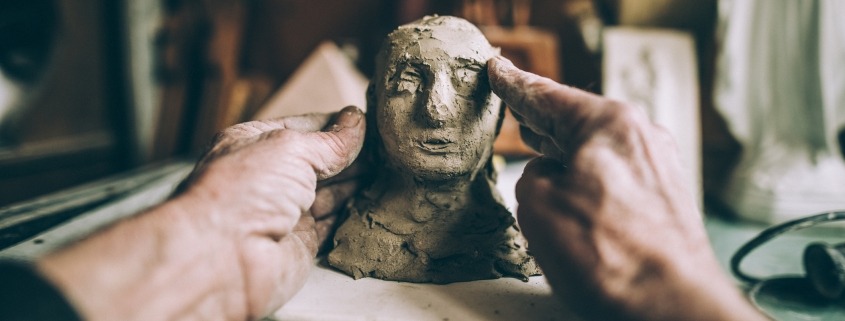Sculpting with Air Dry Clay
No Kiln, No Problem!
Air dry clay, as its name suggests, is clay that dries with air. It doesn’t require a kiln to cure and harden it, making the process of creating a sculpture more accessible and less complicated (no kiln explosions here!). It usually has a soft, spongy, and light texture, making it easy to shape and manipulate. As a result, air dry clay lends itself to common hand-building techniques, such as coiling, slab construction, or sculpting on an armature.
Once it fully dries, air dry clay has the consistency of soft wood, feeling spongy with a slight give. Unlike ceramic clay, it won’t shatter when dropped. Instead, it is more durable and will likely only dent or chip if handled roughly.
Strong Foundations
An armature is the inner support system of a sculpture. Armatures can be built with many different materials, the most common one being wire. With traditional ceramic clay, sculptures can be built around armatures, but the armature must be removed before firing since it could potentially burn or melt in the kiln. Air dry clay, as we mentioned, doesn’t need a kiln. As a result, air dry clay sculptures can have an integrated armature, which will provide extra strength for the lifetime of the sculpture. Consequently, many unique structures can be achieved!
For air dry clay sculptures, a variety of different materials can be used to build an armature. When building your armature, consider the weight and thickness of your sculpture while focusing on stability and strength. If your armature is not strong or stable enough, your sculpture may deteriorate and crack later on. In addition, since the armature will remain inside the sculpture, be sure to use materials that will not rust or decompose, which could compromise the structure.
Wire: For smaller sculptures, wire can almost be enough to provide the support a sculpture needs.
Wooden dowels: Light and strong.
Electrical tape: Good for securing dowels.
Aluminum foil: Good for bulking out the figure once the armature is complete.
Hot glue/super glue: Good for making quick attachments that are then strengthened with another material.
Mixed Media
Another big plus to sculpting with air dry clay is the opportunity to use mixed media materials as you sculpt rather than after. While ceramic sculptures can have other materials added after they have been fired, air dry clay sculptures can have those pieces integrated from the beginning. Consequently, air dry clay offers artists a lot of unique opportunities during the sculpting process.
Tools
Shaping
For many, shaping with fingers and hands gets the job done. But when it comes time for details, classic wooden pottery tools come in handy. Another great shaping tool you are sure to already have is small brushes. They can smooth the clay, create small details, get into tight areas, and, with some added moisture, can soften areas that need reshaping.
Carving
Once dry, air dry clays can be carved. This is helpful if you would like to reduce clay in an area and reshape it as desired. Carving can also add interesting textures to your piece and create unique effects, such as faceting. However, the air dry clay sculpture must be really dry before carving. Otherwise, you will likely tear the clay instead of achieving a clean carve. Many will use a sharp X-Acto knife to carve, but sculptors must be careful as anyone can easily cut themselves.
Smoothing
Need to smooth some areas now that your sculpture is done? There are several different approaches to take. For wet techniques, you can use your fingers or a hard, smooth surface like the back of a spoon to push down texture. For a dry technique to smoothing, you can use sandpaper to get a velvety soft finish. However, sanding is messy and should preferably be done outdoors.
Ready to start experimenting with air dry clay?
Sign up for the LEC’s Creative Clay class today!





Leave a Reply
Want to join the discussion?Feel free to contribute!